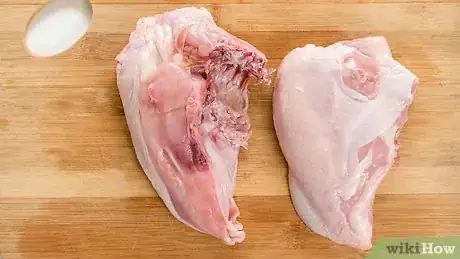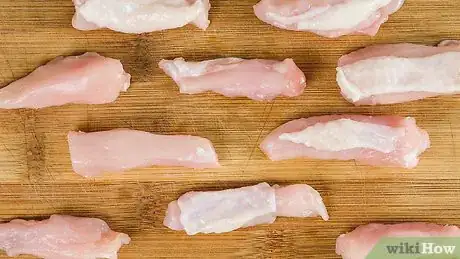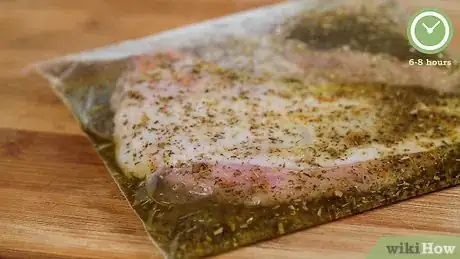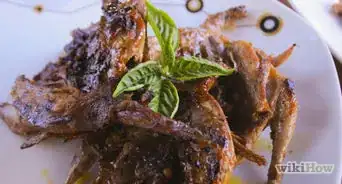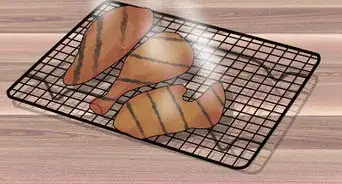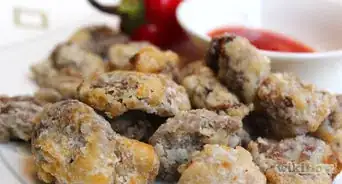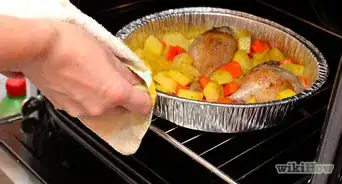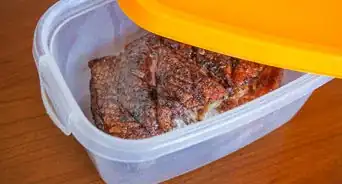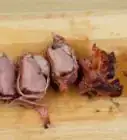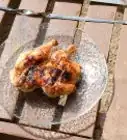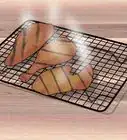This article was co-authored by Jillian Fae Downing and by wikiHow staff writer, Amber Crain. Jillian Fae Downing is a Private Event Chef, Chef Educator, and the Owner of Jillian Fae Chef Services based out of Temecula, California. With 12 years of experience, she specializes in menu planning and menu research and development. Jillian Fae holds an Associate of Science in Culinary Arts from Orange Coast College and a BA in Mass Communication and Media Studies from Arizona State University. She is also a member of the American Culinary Federation and the American Personal and Private Chef Association.
There are 7 references cited in this article, which can be found at the bottom of the page.
This article has been viewed 24,080 times.
Chicken breasts are notorious for becoming unpleasantly dry during the cooking process. To keep your chicken juicy, preparation is key. Don't remove the bones or skin, since they keep the meat juicy during cooking. Pound the raw breasts with a meat tenderizer until each piece is of equal thickness. Submerge the prepped chicken in a brine or marinade for a few hours to ensure a juicy and flavorful result. When you're ready to cook the breasts, do so quickly using high heat. Use an instant-read thermometer to monitor the temperature and remove the breasts from heat when they reach 160° F (71° C).
Steps
Prepping, Cutting, and Pounding the Meat
-
1Keep the bones in and skin on, if possible. Fat keeps meat moist, and chicken breasts naturally have very little fat. Removing the bones and skin lowers the fat content even more, often resulting in dry chicken. You can always remove the skin and bones after you cook the chicken breasts, especially if you don’t want to consume the fatty skin.[1]
-
2Slice the meat into similar-sized pieces if you need cutlets. If you’re cutting up your chicken breast for a dish like fajitas, try to cut the pieces as evenly as possible. If you bought a package of pre-cut cutlets, trim them so they are all very close in size. The pieces don’t have to be identical, but get as close as you can.[2]
- When you cook pieces of chicken that aren't similar in size, the small pieces will end up dry and overdone.
Advertisement -
3Use a meat tenderizer to pound the breasts to the same thickness. Cut each breast in half first, since they’ll be pretty big after you pound them. Once halved, cover one piece in plastic wrap to prevent a mess. Use a meat tenderizer to pound the meat until the piece has an even thickness. Concentrate on the thickest areas, and pound them down to be even with the thinnest area of the breast. Once you’re happy, move on to the next piece and repeat.
- Be sure to pound all the pieces to be about the same thinness so they will cook evenly.[3]
- If you don’t have a meat tenderizer, improvise with a rolling pin.
Using Brines and Marinades
-
1Combine salt and water to create a basic brine solution. Brining is an easy and effective way to keep chicken juicy. Choose a bowl that is large enough for all of your chicken breasts. Add ¼ cup (75 g) of regular salt to the bowl. Pour in 4 cups (950 ml) of water. Stir the brine until the salt dissolves.[4]
- Try adding a handful of fresh herbs to your brine for an added kick.[5]
- If you want to add some sweet element, try ⅛ cup of sugar, honey, agave syrup, or maple syrup.
- If you need a general ratio to create brine a lot of meat, use 1 tablespoon (14.8 ml) of salt for every 1 cup (240 ml) of water.
- You can use a little bit of hot water to dissolve the salt (and the sweetener, if you choose to add it), but then you definitely want to cool it down. Consider adding ice until it gets to your desired ratio to cool it down quicker, but don't put raw chicken in hot water.
-
2Submerge the chicken in the brine for 30 to 60 minutes. Add all of your breasts to the brine solution. Be sure they are all fully submerged. Cover the bowl and put it in the fridge for 30 to 60 minutes. Remove the bowl, drain the brine, and proceed with your recipe.[6]
- The salt will not make your breasts overly salty, but the flavor will be enhanced.[7]
- If you're cooking a lot of chicken, consider brining the meat for 2 to 3 hours.
-
3Soak your chicken in a marinade for 6 to 8 hours for a richer flavor. Marinades add flavor and keep your chicken juicy. You can experiment with a range of store-bought marinades, or make your own at home. Put the marinade in a heavy-duty zip-lock bag, then fully submerge the breasts in the marinade. Seal the bag tightly and put it in the fridge. After 6 to 8 hours, drain the marinade and proceed with your recipe.
- Examples of store-bought marinade flavors you can try are Lemon Pepper, Orange Sesame, and Teriyaki.
Cooking the Chicken Breast
-
1Preheat before adding the chicken. No matter what cooking method you choose, always preheat before adding the chicken. To keep the breasts juicy, they need to cook quickly using high heat. Preheating ensures that your grill, oven, skillet, etc. is at full temperature and ready to go when you add the meat to it.
- An oven is ready when the "Preheat" light turns off, or it beeps.
- For a gas grill, turn the heat to high and put the lid on for 10 to 15 minutes.[8] For a charcoal grill, close the lid and let it heat up for 5 minutes.[9]
- For a skillet, place it on a burner over medium heat for 2 to 3 minutes. Flick a drop of water into the skillet; if it sizzles, the skillet is preheated.
-
2Cook the breasts quickly using high heat. Remove the chicken from the brine or marinade and place the breasts in the oven, on the grill, or in the skillet immediately. Make sure all of the pieces are receiving the same amount of heat. Flip the breasts as needed, if your recipe or cooking method requires it.[10]
-
3Monitor the internal temperature until it reaches 160° F (71° C). Use an instant-read thermometer to monitor the temperature. Insert the wand about 1 in (2.5 cm) into the meat at the center of the breast. If your breasts have been pounded quite thin, insert the wand horizontally, from the side, rather than sticking it into the top. Chicken breast is ready once it’s internal temperature reads 160° F (71° C).[11]
- It should still be juicy at this temperature. Anything over that will compromise the juiciness.
-
4Remove the skin and serve the chicken immediately. Let the breasts cool for about 5 minutes before handling and plating them. If you left the skin on but don't want to consume the it, remove the skin right before you serve the chicken. Simply cut into the meat and pull the skin away with your fingers or a fork. It will come away easily. Plate the chicken and serve immediately.
References
- ↑ https://www.bonappetit.com/test-kitchen/common-mistakes/article/common-mistakes-chicken-breast
- ↑ http://www.simplyrecipes.com/recipes/how_to_grill_juicy_boneless_skinless_chicken_breasts/
- ↑ http://asweetandsavorylife.com/recipe/how-to-cook-tender-juicy-not-dry-chicken-breasts/
- ↑ http://www.thekitchn.com/use-a-quick-brine-to-make-any-cut-more-tender-47879
- ↑ https://www.thekitchn.com/5-ways-to-make-chicken-breast-more-interesting-tips-from-the-kitchn-212214
- ↑ http://www.thekitchn.com/use-a-quick-brine-to-make-any-cut-more-tender-47879
- ↑ http://www.simplyrecipes.com/recipes/how_to_grill_juicy_boneless_skinless_chicken_breasts/
- ↑ https://www.thekitchn.com/5-mistakes-to-avoid-when-using-a-gas-grill-231020
- ↑ https://www.cooksillustrated.com/how_tos/9579-why-gas-grills-need-to-preheat-longer
About This Article
To make your chicken breasts juicy, pound them with a rolling pin so they're the same width, which means they'll cook evenly. Then, give the breasts a richer flavor and more moisture by putting a marinade in a zip-lock bag, adding the breasts, and leaving the bag in the fridge for 6-8 hours. When you're ready to cook, pre-heat your oven and bake the breasts on a high heat until they're done. Allow the chicken to rest for 5 minutes before serving. To learn how to brine your chicken to keep it juicy, keep reading!
